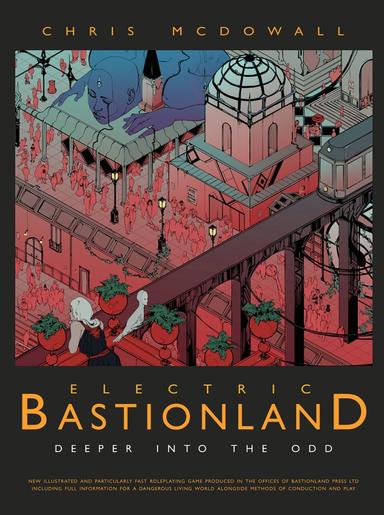I’m on a study project to improve my understanding of roleplaying games. To this end, I already have two reading projects, A Game Per Year and An Adventure Per Year. This is the third, with the goal of reading or playing 52 games made in the last few years. Originally I considered making this “A New RPG Per Week” and that’s where the number 52 comes from, even though a weekly schedule is probably not within my abilities.

There are a few different ways to categorize and contextualize the roleplaying game Electric Bastionland. In an afterword, the designer Chris McDowall situates the game within the OSR tradition and indeed there are similarities in terms of assumed playstyle and the simple, familiar game mechanics that make it easier to jump into the surrealism of the setting.
The other context that came to my mind was roleplaying games set in surreal, impossible cities. Sigil of the AD&D 2nd Edition setting Planescape is one example, but the more relevant one is the titular City of Itra in Itras by.
Electric Bastionland’s Bastion is a vast metropolis emerging into modernity, an urban sprawl bathed in the light of electricity and eccentricity. It’s defined in terms of contrast to other setting elements like the rural and decidedly backwater Deep Country.
The characters are deep in debt and thus forced to engage in dangerous pursuits to get money. At times, Electric Bastionland felt like the lovechild of Troika and the book Debt: the First 5000 Years which describes the way debt motivated early explorers and colonizers.
Each character has a former career. The book features a cool 100 of these, each with its own game mechanics and visuals. Examples are Urban Safarist and Under-Laborer.
Although Itras by and Electric Bastionland have their similarities, in presentation they’re strikingly different. Like many roleplaying books, Itras by uses language, words, sentences and paragraphs to convey its design.
- In contrast, Electric Bastionland uses bullet points and illustrations.
- Its ease of use depends on how good you’re at absorbing design intent from mechanics, tables and minimalist expression.
- The game has a very strong, singular identity and I appreciate how well thought-out the presentation is.
- The book reads like a rules reference affixed to a collection of prompts. Need an idea? Just open at random.